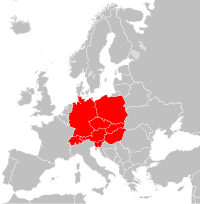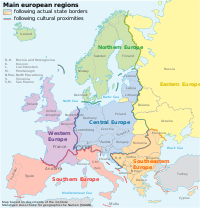
Back Iërupa Teungoh ACE Sentraal-Europa Afrikaans Mitteleuropa ALS ማዕከላዊ አውሮፓ Amharic Europa Central AN أوروبا الوسطى Arabic وسط اوروبا ARZ Europa Central AST Istefa Europa AVK Mərkəzi Avropa Azerbaijani
Central Europe is a geographical region of Europe between Eastern, Southern, Western and Northern Europe.[3][4] Central Europe is known for its cultural diversity;[5][6] however, countries in this region also share historical and cultural similarities.[7][8]
Whilst the region is variously defined, it often includes Austria, Croatia, the Czech Republic, Germany, Hungary, Liechtenstein, Lithuania, Poland, Slovakia, Slovenia, Switzerland and Transylvania as part of Romania.[1][2] From the early 16th century[9][10] until the early 18th century,[11] parts of present-day Croatia and Hungary were under Ottoman rule. During the 17th century, the empire also occupied southern parts of present-day Slovakia.[12][13] During the Early Modern period, the territories of Poland and Lithuania were part of the Polish–Lithuanian Commonwealth. Meanwhile, the Archduchy of Austria, the Kingdom of Bohemia (Czech Republic), the Duchy of Carniola (part of present-day Slovenia), the various German Principalities and the Old Swiss Confederacy were within the Holy Roman Empire. By the end of the 18th century, the Habsburg monarchy, a prominent power within the Holy Roman Empire, came to reign over the territories of Austria, Bosnia and Herzegovina, Croatia, the Czech Republic, Hungary, Slovakia and Slovenia, alongside parts of Serbia, Germany, Italy, Poland and Switzerland.[14]
Since the Cold War the countries that make up Central Europe have historically been, and in some cases continue to be,[15] divided into either Eastern or Western Europe.[16][17] After World War II, Europe was divided by the Iron Curtain[18] into two parts, the capitalist Western Bloc and the socialist Eastern Bloc, although Austria, Switzerland and Yugoslavia (encompassing the territories of present-day Croatia, Slovenia and various other Balkans nations) declared neutrality. The Berlin Wall was one of the most visible symbols of this division.[19] Respectively, countries in Central Europe have historical, cultural and geopolitical ties with these wider regions of Europe.[20][21][22][23]
Central Europe began a "strategic awakening" in the late 20th and early 21st century,[24] with initiatives such as the Central European Defence Cooperation, the Central European Initiative, Centrope, and the Visegrád Four Group. This awakening was accelerated by writers and other intellectuals, who recognized the societal paralysis of decaying dictatorships and felt compelled to speak up against Soviet oppression.[25]
- ^ a b "The World Factbook: Field listing – Location". The World Factbook. Central Intelligence Agency. 2009. Archived from the original on 24 May 2011. Retrieved 3 May 2009.
- ^ a b Jordan, Peter (2005). "Großgliederung Europas nach kulturräumlichen Kriterien" [The large-scale division of Europe according to cultural-spatial criteria]. Europa Regional. 13 (4). Leipzig: Leibniz-Institut für Länderkunde (IfL): 162–173. Retrieved 21 January 2019 – via Ständiger Ausschuss für geographische Namen (StAGN).
- ^ Lecture 14: The Origins of the Cold War. Historyguide.org. Retrieved 29 October 2011.
- ^ "Central Europe –The future of the Visegrad group". The Economist. 14 April 2005. Retrieved 7 March 2009.
- ^ Rac, Katalin (2023). "Diversity and Belonging in Modern Central Europe" (PDF). University of Florida. Retrieved 20 October 2023.
- ^ Kolman, Ludek; Noorderhaven, Niels G.; Hofstede, Geert; Dienes, Elisabeth (February 2003). "Cross-cultural differences in Central Europe". Journal of Managerial Psychology. 18 (1): 76–88. doi:10.1108/02683940310459600. ISSN 0268-3946.
- ^ "Central European Identity in Politics – Jiří Pehe" (in Czech). Conference on Central European Identity, Central European Foundation, Bratislava. 2002. Retrieved 31 January 2010.
- ^ Zepetnek, Steven Tötösy de (2002). Comparative Central European Culture. Purdue University Press. ISBN 978-1-55753-240-4.[page needed]
- ^ Moačanin, Nenad (2019), "The Ottoman Conquest and Establishment in Croatia and Slavonia", The Battle for Central Europe, Brill, pp. 277–286, doi:10.1163/9789004396234_014, ISBN 978-90-04-39623-4, retrieved 16 December 2023
- ^ Szabó, János (2019), "The Ottoman Conquest in Hungary: Decisive Events (Belgrade 1521, Mohács 1526, Vienna 1529, Buda 1541) and Results", The Battle for Central Europe, Brill, pp. 263–275, doi:10.1163/9789004396234_013, ISBN 978-90-04-39623-4, retrieved 16 December 2023
- ^ Ingrao, Charles; Samardžić, Nikola; Pešalj, Jovan, eds. (12 August 2011). The Peace of Passarowitz, 1718. Purdue University Press. doi:10.2307/j.ctt6wq7kw.12. ISBN 978-1-61249-179-0. JSTOR j.ctt6wq7kw.
- ^ "The Ottoman History of Slovakia". The Slovak Spectator. 2010. Retrieved 30 December 2023.
- ^ Ágoston, Gábor (1998). "HABSBURGS AND OTTOMANS: Defense, Military Change and Shifts in Power". Turkish Studies Association Bulletin. 22 (1): 126–141. ISSN 0275-6048. JSTOR 43385414.
- ^ Benabdeljalil, Ilyas (15 February 2022). "The Habsburgs: A Millennia-Old Dynasty (Part II)". The Collector. Retrieved 20 October 2023.
- ^ "Standard country or area codes for statistical use (M49)". Methodology. United Nation Statistics Division. Retrieved 12 September 2023.
- ^ Berglee, Royal (2016). "2.3 Regions of Western Europe". World Regional Geography. University of Minnesota. 2.16 Traditional Regions of Europe.
- ^ Shvili, Jason (10 May 2021). "Regions Of Europe". WorldAtlas. Retrieved 23 August 2023.
- ^ "Iron Curtain Trail – EuroVelo 13". Council of Europe. Retrieved 17 October 2023.
- ^ "The Berlin Wall | Berlin Wall Foundation". stiftung-berliner-mauer.de. Retrieved 17 October 2023.
- ^ "Fall of Communism in Eastern Europe, 1989". U.S. Department of State.
- ^ "Western European Union – Archive of European Integration". aei.pitt.edu. Retrieved 25 August 2023.
- ^ "Southeast European Cooperative Initiative (SECI)" (PDF). United Nations Economics Commission for Europe. Retrieved 25 August 2023.
- ^ Krastev, Ivan (2022). "Reimagining the East-West Divide in Europe". Institute for Human Sciences. Retrieved 20 October 2023.
- ^ "The Mice that Roared: Central Europe Is Reshaping Global Politics". Der Spiegel. 26 February 2006. Retrieved 31 January 2010.
- ^ "The Tragedy of Central Europe". European Parliament. 1984. Retrieved 23 August 2023.

